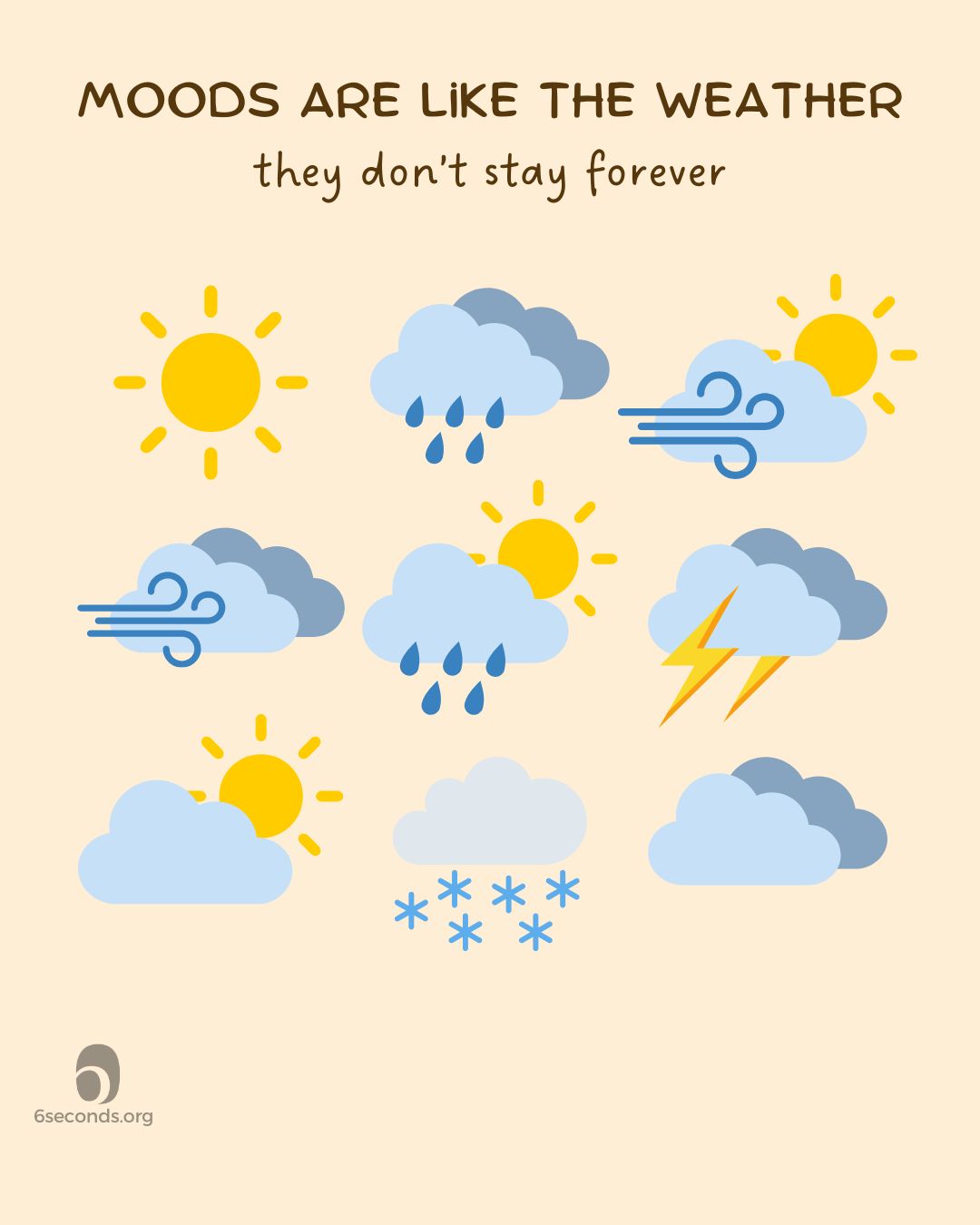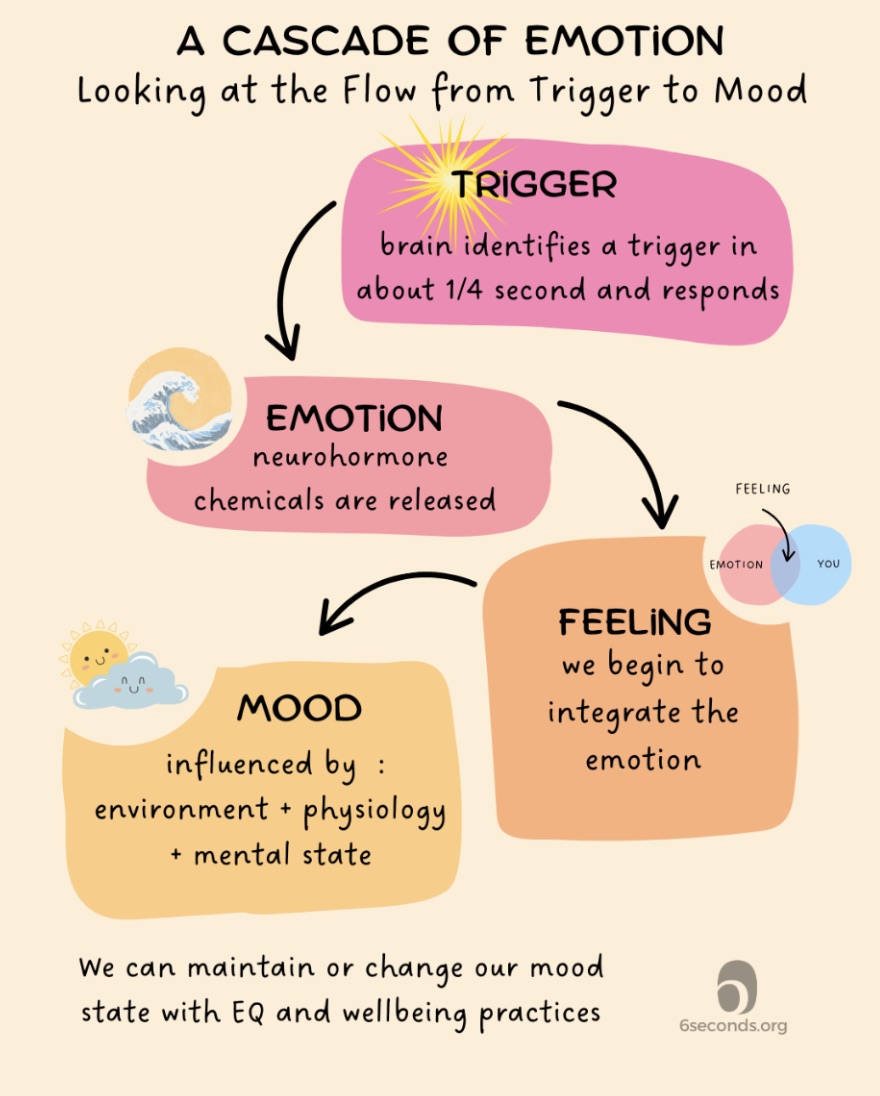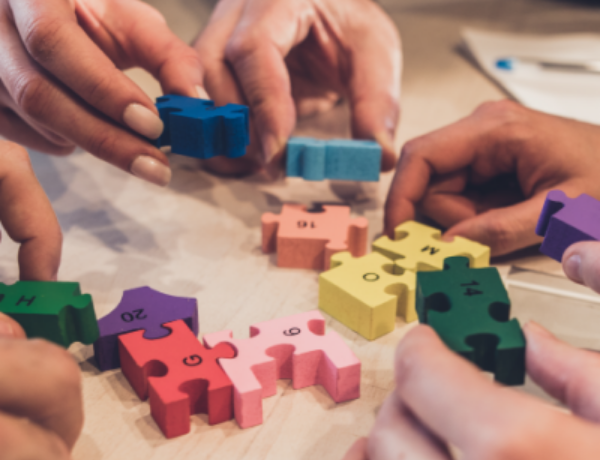Emotions, Feelings & Moods: What’s the Difference and Why It Matters
by Michael Miller & Alexandra Tanon Olsson

Have you ever felt a wave of irritation or confusion during a conversation, then hours later found yourself upset without really knowing why?
Well, there’s a science behind it. We as humans have emotions, feelings, and moods. We often use these words interchangeably, but, believe it or not, they are all different, and we experience them at different moments. Understanding what’s going on underneath the surface helps us become aware and handle those moments better; even be a little kinder to ourselves.
Let’s unpack the difference, with real-life examples and a few simple ways to strengthen your emotional intelligence.
A Matter of Seconds (and Hours… and Days)
Here’s the short version:
Emotions happen first. Then come feelings. And over time, if enough of those feelings linger or stack up, they become a mood.
Scientists have even traced this process in the brain and body.
Emotions spark first in the amygdala, the brain’s radar for threats and opportunities. They send out a surge of chemicals that ripple through the body in less than a second.
Feelings come next, as the prefrontal cortex helps us make meaning of those signals; turning raw energy into something we can name and understand.
And when those feelings stack up or linger, they tip into moods, which are shaped not only by our thoughts and experiences but also by hormones, circadian rhythms, sleep, and even the environment around us.
Emotions: The First Spark
Imagine you’re driving and someone cuts you off. Before you even think about it, your heart jumps, your hands grip the wheel tighter, and you feel a jolt of… something. That’s emotion; a fast, chemical reaction that kicks in less than a second after your brain detects a trigger.
Emotions are like your body’s internal radar system. They show up quickly, ripple through your entire body, and then, amazingly, start to fade after just about six seconds.
Research shows our body reacts before we’re even conscious of danger; the amygdala triggers the hypothalamus, initiating the fight-or-flight response almost instantly.
That’s why our organization is called Six Seconds. As we explain in this blog post, this tiny window gives us a “rare opportunity to interrupt the automatic reaction and consciously choose our response.” It’s in those few seconds that awareness, choice, and intention intersect—allowing us to respond rather than react, to notice our emotions, and to align our actions with our values.
Top Resources to Understand Emotions and Feelings
1 Make sense of emotions with our interactive Plutchik Wheel
2 Go deeper into the neuroscience of emotions, with 7 quick facts:
3 Escape the negative emotions trap with a new perspective on emotions:
Feelings: The Meaning-Makers
Let’s go back to that moment in the car. After the initial shock passes, maybe you start replaying it in your head. “Why are people so careless?” “I could’ve been hurt.” “I’m still shaky.”
Now you’re not just reacting; you’re feeling.
Here’s another example: Imagine you’re in a meeting and a colleague dismisses your idea. The flash of embarrassment (emotion) quickly turns into frustration or insecurity (feeling). If you keep replaying it, those feelings may linger and shape how you show up with your team the rest of the day.
Feelings are what happen when your brain starts to process the emotional chemicals. They’re more complex and layered. You might feel angry, afraid, vulnerable, or all three at once. Feelings last longer than emotions, and they often tell a story: about who we are, what matters to us, and how we make sense of the world.
Neuroimaging research demonstrates that labeling your emotions—such as saying “I feel anxious”—activates the right ventrolateral prefrontal cortex and reduces activity in the amygdala. This shift engages the brain’s reasoning and self-control centers, helping to calm the body, lower stress hormone levels, and create space for thoughtful responses. Over time, regularly naming emotions strengthens neural pathways, making it easier to pause, reappraise situations, and respond with clarity and resilience rather than reacting automatically. This process is central to emotional intelligence, as it allows us to move from raw reaction to intentional action.
Moods: The Weather Patterns
Now imagine you’ve had a few stressful moments like that recently. You’re sleep-deprived, your coffee spilled, and your toddler skipped their nap (again). By mid-afternoon, everything feels a little heavier. You’re not just frustrated by one thing; you’re in a mood.
Think of moods like the emotional weather system. Just as a cloudy sky can cast a gray filter over everything, a mood can tint how we interpret what’s happening. A partner forgetting something important, for example, might spark irritation (emotion), then hurt (feeling), and if it lingers, a mood of disconnection that colors the whole day.
In the workplace, this matters too. A leader who’s under pressure may experience a flash of stress (emotion) that turns into tension or frustration (feelings). If those feelings persist, they can slip into a negative mood: one that influences tone, communication, and team energy even without a specific trigger.
Moods are more generalized. They aren’t tied to one event, but rather shaped by many things: your environment (like weather or noise), your body (hormones, health, what you ate), and your mind (where your attention is going). A mood can last hours or even days, coloring how we see the world.
Scientists note that moods aren’t just “in our heads” but shaped by biology and environment; everything from hormonal changes to weather and daylight exposure can influence mood patterns.
Researchers also emphasize that while moods can linger, they aren’t fixed. Simple practices like movement, social connection, or stepping outside can help shift our emotional “weather system”.

Emotions vs Feelings vs Moods: A Side-by-Side Comparison
What it is
How long it lasts
Why it matters
Emotion
A quick chemical response to a trigger
~6 seconds
Gives us data about threats and opportunities
Feeling
The mental and physical sensations that arise as you process the emotion
Minutes to hours
Helps us make meaning and respond
Mood
A more persistent emotional state
Hours to days
Keeps us attuned to our environment over time
Why Understanding Emotions, Feelings, and Moods Is Essential for Emotional Intelligence
When we don’t understand what’s happening inside us, it’s easy to get stuck. We may think, “I am an anxious person,” when in reality, we’re just caught in a mood built from unspoken feelings that started with a very real emotion. Emotions are fast, automatic responses to events, whereas feelings are our brain’s interpretation of those emotions, and moods are longer-lasting, more diffuse states. Without awareness of these layers, it’s easy to let them escalate.
The common advice is to ignore emotions or push them aside—but research and emotional intelligence practice show that this is exactly how they become more challenging feelings or persistent moods. Suppressing or denying what we feel often leads to heightened stress, lingering tension, or reactive behavior. By noticing and naming what we feel, even briefly, we interrupt that automatic escalation and give ourselves the chance to respond more thoughtfully.
Emotional intelligence starts with awareness—and awareness gives us choice. You don’t have to “fix” every emotion or “snap out of” every mood, but you can start by observing, labeling, and being curious about what’s happening inside you. Even small shifts—like taking a breath before reacting, pausing to ask “what am I actually feeling?”, or considering what this emotion is trying to tell you—can influence your decisions, your relationships, and your overall well-being.
These practices are at the heart of emotional intelligence and are central to the Six Seconds Model of Emotional Intelligence, which guides us from raw emotional reaction to intentional, values-aligned action. By moving through the steps of Know → Choose → Give, we create space to process emotions instead of being controlled by them—transforming difficult moments into opportunities for clarity, resilience, and growth.

3 Simple Ways to Build Emotional Awareness and Intelligence
Here are three ways to build your emotional literacy:
- Name your feelings
This simple act engages both the emotional and cognitive parts of your brain. Say it out loud or write it down: “I feel… overwhelmed / hopeful / irritated / grateful.” (Yes, you can feel multiple things at once.) Naming your feelings helps you create a pause between emotion and reaction. - Get curious about emotions
Explore the full spectrum of emotions—not just “happy” or “sad,” but also anticipation, trust, surprise, and more. Each emotion has a purpose, and when we can name them, we can understand ourselves and others better. Tools like our interactive Plutchik’s Wheel help you map out and reflect on your emotions in real time. - Practice with Tools
- eMotion Feeling Cards are perfect for self-reflection, or to use with kids, partners, or teams. They help you notice and express emotions in the moment, spark meaningful conversations, and build empathy.
- To take things a step further, the Practicing EQ eBook offers structured activities, guided reflections, and practical exercises that complement the cards, helping you turn daily awareness into intentional, lasting practice.
Practical Ways to Shift Emotions, Feelings, and Moods
Pause & Breathe: Take one slow, deep breath when you notice an emotion rising. This calms the nervous system and creates space to respond rather than react.
Move Your Body: Even 5–10 minutes of walking or stretching helps reset your mood and release tension.
Reframe the Situation: Ask, “What’s another way to look at this?” or “What’s within my control?”
Engage Your Senses: Step outside, notice the sun, listen to sounds around you, or touch something calming—these anchor you in the present.
Connect: Share feelings with a trusted friend or colleague to process them, rather than ruminating alone.
When you understand the difference between emotions, feelings, and moods, you can stop being swept away by them and start using them as the signals they were always meant to be.
If you’d like to keep exploring, join one of our free monthly EQ Cafés: global gatherings where we practice emotional intelligence in real life. Or dive deeper with our upcoming webinars or courses, like Unlocking EQ. Because the more we understand emotions, feelings, and moods, the more choice we have to shape our lives.
Mini FAQ: Common Questions About Emotions, Feelings, and Moods
Q: Can I change my mood quickly?
A: Yes! Small shifts—like taking a few deep breaths, stepping outside, or moving your body—can help reset your emotional “weather system.”
Q: How does emotional intelligence help at work?
A: Understanding your emotions and feelings allows you to respond rather than react. This improves communication, collaboration, and leadership presence.
Q: What if I feel multiple emotions at once?
A: That’s normal. Labeling each emotion individually helps you understand patterns and make thoughtful choices about how to respond.
Want a little more inspiration? Together we can grow emotional intelligence.
Grab our free Practicing EQ eBook for simple, practical ways to start today!

Articles
Stay up to date on the latest emotional intelligence articles, case studies, research and more.

Videos
Join livestreams and learn from 1000s of free emotional intelligence videos on YouTube.

Newsletters
Get practical tips to apply EQ in Business, Coaching, Education, Parenting and more.

eLearning
Sign up for our top rated course on Udemy: Emotional Intelligence at Work.

Certification
Join Unlocking EQ – a 1-day deep dive into the why, what and how of EQ.

Events
Join us online or in person to experience the Six Seconds way!

